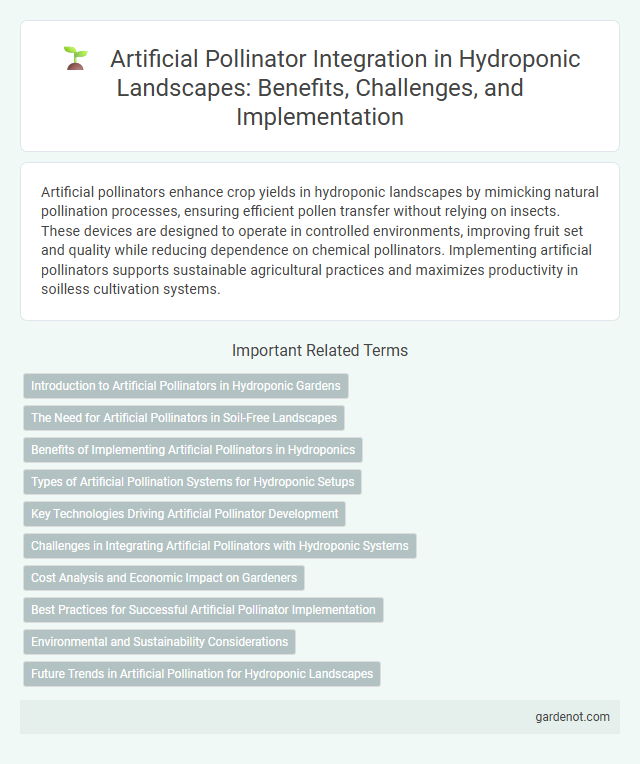Artificial pollinators enhance crop yields in hydroponic landscapes by mimicking natural pollination processes, ensuring efficient pollen transfer without relying on insects. These devices are designed to operate in controlled environments, improving fruit set and quality while reducing dependence on chemical pollinators. Implementing artificial pollinators supports sustainable agricultural practices and maximizes productivity in soilless cultivation systems.
Introduction to Artificial Pollinators in Hydroponic Gardens
Artificial pollinators in hydroponic gardens are innovative devices designed to mimic the natural pollination process, crucial for fruit and vegetable production in controlled environments. These tools use mechanical vibrations, airflow, or robotic arms to transfer pollen efficiently among plants, ensuring higher yield and improved crop quality without relying on insect activity. Integrating artificial pollinators enhances pollination precision and consistency, addressing challenges posed by the lack of natural pollinators in indoor hydroponic setups.
The Need for Artificial Pollinators in Soil-Free Landscapes
Artificial pollinators are essential in hydroponic landscapes due to the absence of natural pollinating insects typically found in soil-based environments. These systems rely on manual or mechanical methods to ensure effective flower pollination, which directly impacts fruit set and crop yield. Implementing artificial pollination techniques enhances productivity and supports sustainable agriculture in controlled, soil-free cultivation systems.
Benefits of Implementing Artificial Pollinators in Hydroponics
Implementing artificial pollinators in hydroponic systems enhances crop yield and quality by ensuring consistent and efficient pollen transfer even in controlled indoor environments. These devices reduce the dependency on natural pollinators, minimizing crop loss caused by their absence or decline, while facilitating year-round production. Enhanced pollination accuracy also improves fruit set and uniformity, contributing to higher market value and profitability in hydroponic farming.
Types of Artificial Pollination Systems for Hydroponic Setups
Artificial pollination systems for hydroponic setups include manual methods, mechanical vibrators, and automated air blowers designed to mimic natural pollination processes. Mechanical vibrators, commonly used in tomato hydroponic farms, stimulate pollen release by applying targeted vibrations to the flowers. Automated air blowers distribute fine airflow to transfer pollen efficiently across densely planted hydroponic modules, enhancing fruit set and yield in controlled environment agriculture.
Key Technologies Driving Artificial Pollinator Development
Key technologies driving artificial pollinator development include advanced robotics, artificial intelligence (AI), and sensor integration, enabling precise flower identification and targeted pollen transfer in hydroponic landscapes. Machine learning algorithms optimize pollination efficiency by adapting to plant species and environmental variables, while micro-electromechanical systems (MEMS) enhance mobility and dexterity in navigating dense hydroponic setups. These innovations collectively improve crop yield and sustainability in controlled-environment agriculture.
Challenges in Integrating Artificial Pollinators with Hydroponic Systems
Integrating artificial pollinators into hydroponic systems faces challenges such as ensuring precise pollination timing and mimicking natural pollinator behaviors to maximize fruit set and quality. Technical difficulties include developing sensors and robotic mechanisms that operate effectively in controlled environments without damaging delicate plants or disrupting airflow. Energy consumption and maintenance costs remain significant barriers to widespread adoption in commercial hydroponic farming.
Cost Analysis and Economic Impact on Gardeners
Artificial pollinators in hydroponic landscapes present a cost-effective alternative to manual pollination, reducing labor expenses by up to 40% annually for gardeners. Initial investment in robotic pollinators ranges from $1,500 to $5,000 per unit, with maintenance costs around $200 yearly, resulting in a break-even point within two to three growing seasons. Economic impacts include increased crop yields by 15-25%, boosting revenue and making hydroponic gardening more sustainable and profitable for small to medium-scale growers.
Best Practices for Successful Artificial Pollinator Implementation
Effective artificial pollinator implementation in hydroponic landscapes relies on selecting species like bumblebees or robotic drones that are compatible with specific crop types such as tomatoes or strawberries. Optimizing environmental factors including humidity, temperature, and light intensity enhances pollinator activity and improves fruit set rates. Regular monitoring and maintenance of pollinator health combined with precise timing aligned to flower anthesis stages maximize pollination efficiency and crop yield.
Environmental and Sustainability Considerations
Artificial pollinators in hydroponic landscapes significantly reduce reliance on wild pollinators, thereby preserving biodiversity and minimizing ecological disruption. Their controlled deployment limits pesticide use and water consumption, promoting sustainable agricultural practices within closed-loop systems. By enhancing pollination efficiency, these technologies contribute to higher crop yields while supporting environmental conservation goals.
Future Trends in Artificial Pollination for Hydroponic Landscapes
Future trends in artificial pollination for hydroponic landscapes emphasize the integration of advanced robotics and AI-driven sensors to enhance pollination efficiency and crop yield. Innovations such as drone-based pollinator systems and automated pollen dispensers are being developed to mimic natural pollination processes while minimizing labor costs and environmental impact. These technological advancements aim to support sustainable indoor farming by optimizing pollination timing and precision in controlled hydroponic environments.
Artificial pollinator Infographic

 gardenot.com
gardenot.com